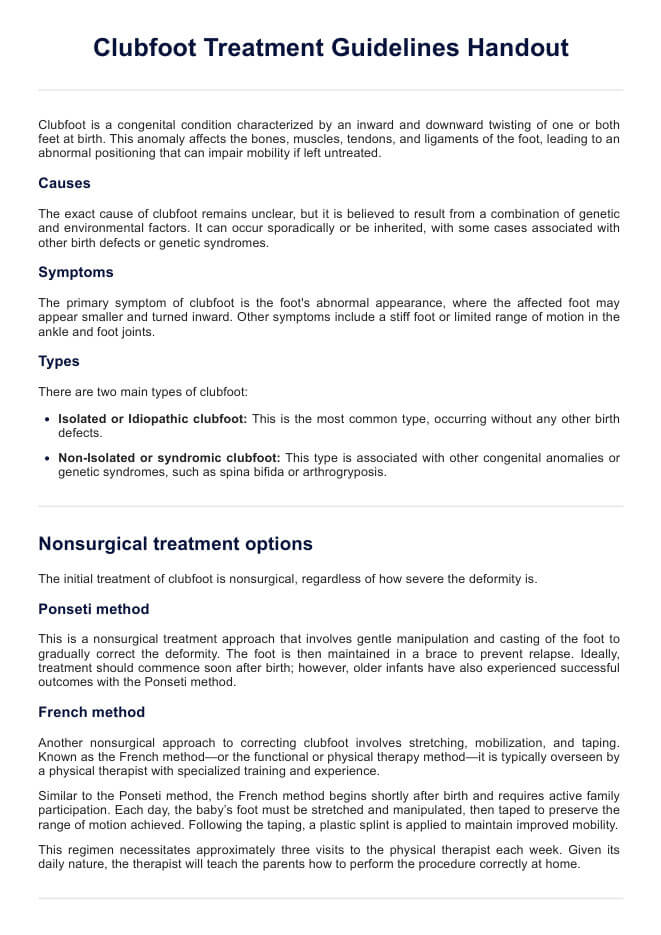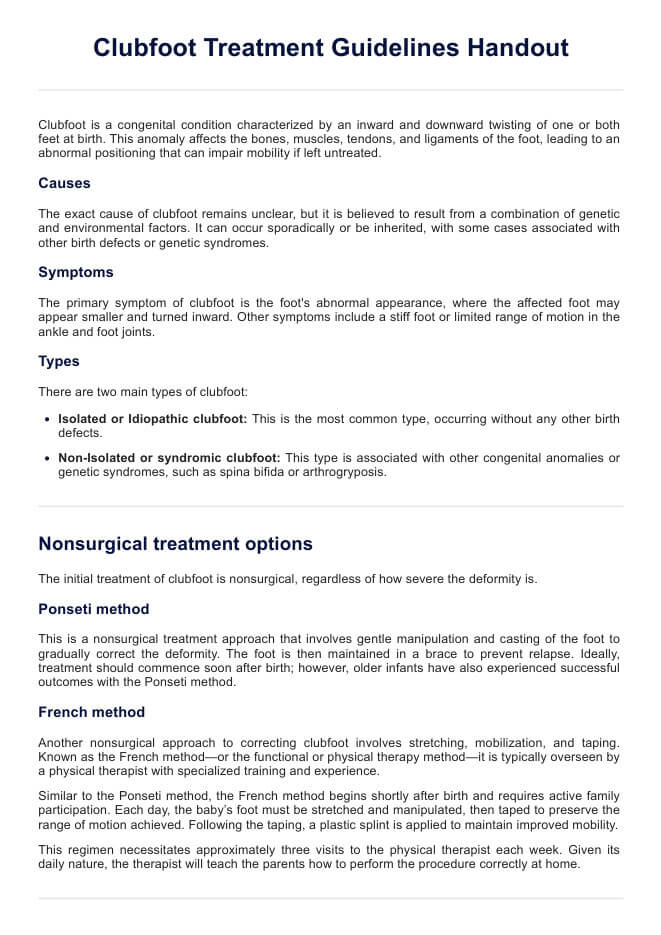Clubfoot Treatment Guidelines Handout
Download Carepatron's free PDF guidelines and examples for clubfoot treatment, providing valuable information and resources for effective management and care.


What is clubfoot?
Clubfoot or congenital clubfoot is one of the many birth defects that affect a baby's foot or feet (American Academy of Orthopaedic Surgeons, n.d.). Symptoms of clubfoot include inward and downward twisting of the affected leg or club foot, placing it in an abnormal position than the correct position. This condition typically occurs in both feet, although it may affect only one foot in some cases. It may also come along with risk factors and may be due to cases in family history.
The most common type, idiopathic clubfoot, occurs without a known cause and affects approximately one in every 1,000 newborns (American Academy of Orthopaedic Surgeons, n.d.). The exact cause remains unclear, but it is believed to involve a combination of genetic and environmental factors.
In a baby with clubfoot, the tendons and ligaments in the affected foot are abnormally tight, causing the foot to point downward and inward. The Achilles tendon, which connects the calf muscles to the heel, is often shortened and tight, contributing to the characteristic clubfoot position.
Early diagnosis and intervention by a child's doctor are crucial for successful treatment and to prevent extensive surgery. While clubfoot is present at birth, it can be corrected with minor surgery, usually starting soon after birth of most babies. Without early treatment, untreated clubfoot can lead to medical problems with walking and mobility later in life.
Clubfoot Treatment Guidelines Handout Template
Clubfoot Treatment Guidelines Handout Sample
Ponseti method
The Ponseti method is a widely used non-surgical approach for treating a child's clubfoot. It involves gentle manipulation and stretching of the baby's foot with clubfoot, followed by the application of plaster casts. These casts are changed weekly to gradually correct the foot's position, allowing the tendons and ligaments to lengthen and the child's foot to align correctly.
French method
An alternative nonsurgical approach to correcting clubfoot involves stretching, mobilization, and taping, and is known as the French method—also referred to as the functional or physical therapy method. This technique is typically managed by a physical therapist with specialized training and experience.
Similar to the Ponseti method, the French method begins shortly after birth and necessitates active family involvement. Each day, the baby’s foot is stretched and manipulated, then taped to maintain the range of motion gained. After taping, a plastic splint is applied to preserve the improved mobility.
Surgical treatments
In some cases, clubfoot may require surgical intervention. This is usually considered if nonsurgical methods do not achieve the desired results or in certain severe cases. The specific surgical approach used will depend on the severity of the clubfoot and the age of the child.
Some common surgical procedures for treating clubfoot include:
- Achilles tenotomy: This procedure involves lengthening a tight Achilles tendon to improve foot flexibility.
- Soft tissue release: In this surgery, soft tissues such as ligaments and tendons are released or lengthened to allow for proper foot alignment.
- Osteotomy: For more complex cases, bones may need to be cut and realigned to correct the foot's position.
Benefits of using this handout
Using our Clubfoot Treatment Guidelines Handout offers several significant benefits for healthcare professionals, parents, and patients alike. Firstly, it provides a structured framework that ensures consistency in treatment approaches, reducing variability in care delivery. This consistency helps healthcare teams follow best practices in clubfoot management, leading to improved treatment outcomes.
Secondly, the handout serves as an educational tool, empowering parents with clear information about the treatment process and expectations. It enhances communication between healthcare providers and parents, fostering a collaborative approach to care. By understanding the steps involved and the importance of brace compliance, parents are better equipped to support their child's treatment journey effectively.
Moreover, the handout promotes efficiency in clinical practice by streamlining the dissemination of essential information. Healthcare professionals can quickly reference treatment protocols, track progress during follow-up visits, and make informed decisions based on standardized guidelines.
Reference
American Academy of Orthopaedic Surgeons. (n.d.). Clubfoot - orthoinfo - AAOS. https://orthoinfo.aaos.org/en/diseases--conditions/clubfoot/#:~:text=Major%20reconstructive%20surgery%20for%20clubfoot
Commonly asked questions
Yes, with early and appropriate treatment, clubfoot can be corrected completely in most cases, allowing the child to lead a normal, active life.
Professionals can correct clubfoot within the first few months of life, starting shortly after birth through methods like the Ponseti method.
The exact cause of clubfoot is unknown, but it is believed to involve a combination of genetic and environmental factors influencing fetal development.
Spina bifida is a birth defect affecting the spinal cord and vertebrae, resulting from incomplete closure of the neural tube during early fetal development. Clubfoot, on the other hand, is a congenital condition where a baby's clubfoot is twisted inward and downward, affecting the bones, muscles, tendons, and ligaments of a foot.







































































































